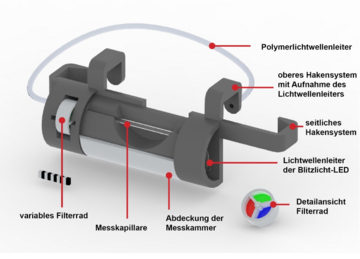Process control in winemaking using a smartphone photometer
Against the backdrop of climate change and increasing population density, issues such as sustainability and food security are becoming increasingly central. This leads to the increased importance of reliable process control in order to avoid rejects due to non-compliance with specifications or legal requirements. This is particularly important for small and medium-sized companies, as the additional financial damage caused by this cannot be tolerated in an already difficult competitive situation. Wine companies in Germany are predominantly made up of just such SMEs. The aim of the AiF project was therefore to develop a cost-effective photometric analysis system for use in the wine industry. In addition, simple, cost-effective analysis methods were to be developed for use in wine cellars.
In the project, a portable photometer was developed that can be manufactured inexpensively by combining light-emitting diodes as the light source and a phototransistor as the sensor. Flexible use of the measuring device is ensured by placing the optical elements on exchangeable circuit boards. The developed measuring circuit guarantees precise measurement. The intuitive operation of the measuring device and the possibility of implementing various measurement protocols is ensured by the associated smartphone app. The app enables parameter-specific integration of measurement sequences and evaluation functions.
Various measurement protocols were (further) developed for wine analysis. On the one hand, a method was developed to display the color of red and white wine in the CIE L*a*b* color space. A calculation was implemented that enables the transmission spectra of wine and then the color coordinates in the CIE L*a*b* color space to be calculated on the basis of individual measurements. In this context, the color determination according to Glories and the correlation of both color determination methods with human perception were also investigated. With the help of machine learning, a model was also developed to distinguish blanc de noir from rosé and white wine.
To determine the crystal stability of wine, measurement protocols for calcium and potassium concentration were adapted, further developed and optimized for use in wine. The same was done for the iron, total phenol and sulphur content, which is related to the oxidation potential. The possibility of using it as a nephelometer was validated by measuring turbidity during the bento test.
As microbiological parameters are also of great importance in practice, these were also investigated in the course of the project. For example, a method for the early detection of malolactic fermentation was determined that allows prediction up to two days in advance. No photometric measurement method has yet been developed for this purpose.
In the course of the project, a portable photometer was developed that is suitable for use in the winery due to its small size, high sensitivity and flexible use. Thanks to the implementation of an app, the measuring device is also suitable for complex measurement routines. Its suitability for complex matrices such as wine was demonstrated using various parameters, although it is not limited to these. The measuring device thus offers a promising perspective for the implementation of cost-effective yet precise process control in the wine industry and beyond.

Anja Moraru

